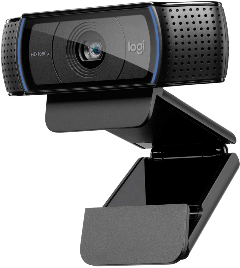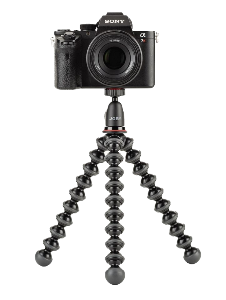
Q: I'm looking for equipment recommendations to achieve a more professional look and sound to my Zoom sessions. What camera and microphone do you advise?
It's been months into the pandemic, and all sorts of life is being lived via video calls. So, we've been working hard to research good, affordable options as instructors now have a handle on the software. To complement our previous Dear A/V about software upgrades to Zoom, let's tackle hardware upgrades. The links to vendors should be seen as reference point. We haven't scoured the internet looking for the best value.
Of course, there are simple tips to help your Zoom presence look and sound better while using your existing equipment, and we have a 2min video covering these tips.
Webcams

If you've yet to add a dedicated webcam to your set-up, this would be a good step for the tech-adverse. A dedicated webcam, such as the one shown here, will often have higher resolution than the built-in webcam in your laptop. They are USB, so they'll be recognized by just about any device, and, with your camera now detached, you can precisely position it to follow Webcam Cinematography fundamentals.
Our shop recommends the Logitech c920 HD Webcam (~$80). Really, any make and model in this price range will deliver comparable results. Some cheaper webcams will be HD but max out at 720 resolution; which is lower than the general expectations of 1080. The Logitech webcam does integrate with a settings application for fine tuning of color, brightness and framing.
Cell Phone as Webcam?
Most modern phones are more camera than they are phone. The rear facing camera on your phone will outperform the forward facing camera and is sometimes even better than a dedicated webcam.. Did you know you can call into a Zoom call with two devices? You could rock your computer for slides and typing while positioning your phone to act as camera (and possibly microphone). The lag isn't distracting enough to sidestep this strategy -- and it opens a world of possible set-ups (Overhead camera shot).
Tripod / Stand

While not a necessary expense, you may enjoy the benefits of a tripod for any of the camera choices we are discussing. Most home or office set-ups don't have the floor plan for traditional tripods. So, our team typically recommends Joby GorrilaPods for the lighter camera rigs we are recommending. The legs are malleable to fit many needs, and the Ball head mounts are a must have to quickly and easily level your camera. The GorrilaPod 1K with Ball Head mount is plenty sufficient for the types of cameras we'll next recommend ...
Mirrorless Camera
Lite weight, fantastic in low light, available for high caliber lenses and [relatively] affordable, these camera models are all the rage among video (and photo) folks these days. Though, with this configuration, just about any camera outputting video over HDMI will suffice.
Our shop is partial to Sony models, and the newest on the block is the A7siii (~$3K new). But, we've also gotten great results with it's little cousin -- the a6400 (~$1K new). If you are more serious about video production outside of using this for Zoom, then that would be the tipping point to go for the A7siii. Canon and Lumix lines of similar tech are equally good options.
Costs: If any of these prices are too steep for you, shop used or older models! The "iii" stands for 3 and is the third in the S-series. Try the ii or even the inaugural model. We have the a6300 in our Instructor Studio, and you'll never notice the difference on Zoom. Video folk often sell their older cameras to upgrade to the latest model. You can swoop in on these after market savings
The key for beginners is to search for and buy with the "kit lens," sometimes called the "standard lens." What a horrid feeling it would be to unbox your new toy only to find it with "body only" and no lens. Rather than doing a deep dive into photography and how lenses work, in which you may end up with an unworkable lens/body combo, better to buy kit. If you are getting a tripod, you won't need many other fixings (other than perhaps, a recommended SD card so you can use outside of Zoom).
Also, to connect this camera to a computer for use in Zoom, you'll need the appropriate HDMI cable. Carefully inspect the product page of your camera. There is full-size HDMI, Mini HDMI and, what most models will have these days, Micro HDMI. Either pick up an adapter or an all-in-one cable to go from your camera to full size HDMI to connect with ...
HDMI → USB adapters
As stated above, with one of these, you can connect just about any camera outputting a video signal over HDMI to Zoom. Our shop employs the $300 Magewell USB Capture HDMI Gen 2. But we've also found success with the $120 Elgato Cam Link 4K and even $16 cheap but works tier! (Buyer beware of hardware this inexpensive). Some manufacturers, such as Canon, have also released software allowing a high-end camera to function like a webcam over USB. In that case, you could connect the camera to the computer directly through USB without an HDMI cable.
Simply plug in your adapter to computer, and Zoom should soon recognize the name of the device as a camera option. You'll have all the same options in Zoom for the camera (HD, Mirror my video, low light), but now you also have all the settings on your mirrorless camera! We recommend beginners flip it to Auto and ensure auto-focus is on, so it's an easy set-up.
Microphones
Our team works extensively with instructors making course content. So rather than digging into all the possible audio production means and methods, we just put together typical options an instructor would consider in this handout. Most are USB-based and will load up as an option in Zoom when you go to select audio source.
The HDMI → USB adapters will also be an option for audio and will carry the audio from your camera. Many mirrorless cameras have a 3.5mm audio jack for a microphone, and our team has found good success with the Rode VideoMicro. But it is perfectly fine to mix camera signal over the adapter with a USB microphone plugged into your computer.
Bob Dignan
Instructional Media Resources (CITL),
rdigna2@illinois.edu | citl-info@illinois.edu
About Dear A/V
CITL’s media team has been flooded with questions from Illinois instructors about the best ways to teach with technology and media. Dear A/V collects the most common and timely questions and our experts’ comprehensive responses.
If you have a question about media in your teaching (or anything in your teaching), write to us at citl-info@illinois.edu and we’ll get back with you. Your question may be featured in an upcoming “Dear A/V”!
To read Dear A/V #3 , visit https://citl.illinois.edu/about-citl/news/2020/11/20/how-do-i-add-interactivity-to-online-video-lectures-dear-a-v-3